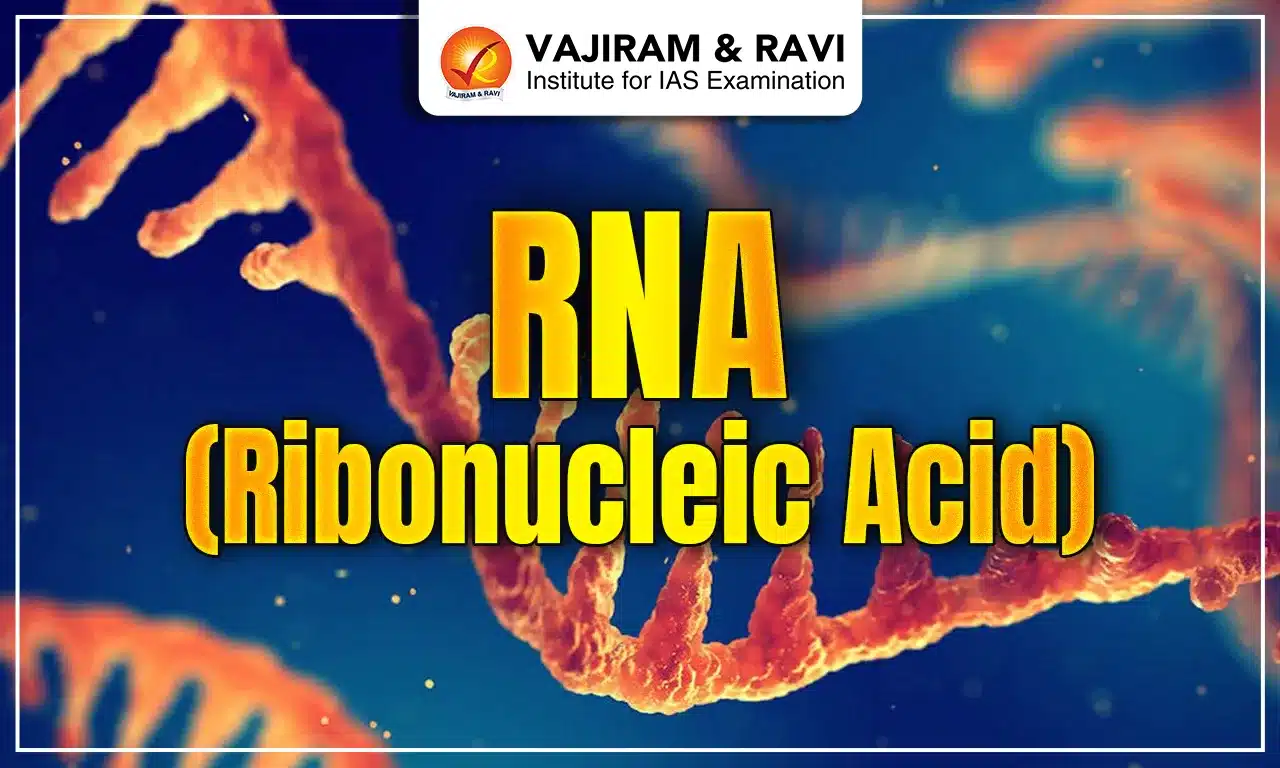Ribonucleic acid (RNA) is a nucleic acid found in all living cells, often single-stranded, made of nucleotides containing ribose sugars, nitrogenous bases, and phosphate groups. It comes in three types: messenger RNA (mRNA), ribosomal RNA (rRNA), and transfer RNA (tRNA). Some RNAs regulate gene expression, while viruses may use RNA as their genetic material. RNA's main role is to create proteins through translation and serves as the primary genetic material for viruses.
Structure of RNA
RNA is a nucleotide polymer composed of ribose sugar, phosphate, and bases such as adenine, guanine, cytosine, and uracil. Uracil, an RNA-specific pyrimidine, forms a complementary base pair with adenine and is used instead of thymine in DNA.

- Single Stranded: The majority of RNA is single-stranded, but there are some double-stranded RNA viruses. The length and structure of the RNA molecule can vary.
- Double helix Characteristics: Most RNA molecules are single-stranded but RNA molecules may contain regions that can form complementary base pairing where the RNA strand loops back on itself.
- Non-complementary sequences may become looped out to form the bulge structure, an internal loop, or a hairpin loop.
- If so, some parts of RNA will have son double-stranded regions.
- Ribosomal RNAs (rRNAs) and transfer RNAs (tRNAs), as well as some messenger RNAs (mRNAs), have significant secondary structures.
- The slight structural difference between the sugars adds stability to DNA, making it more suitable for genetic information storage, whereas RNA's relative instability makes it more suitable for its more short-term functions.
- Secondary structure: Two hydrogen bonds form between adenine and uracil, while three bonds form between cytosine and guanine. The secondary structure of RNA is based on base pairing via hydrogen bonds.
- Tertiary Structure: The RNA tertiary structure results from RNA folding, which produces a three-dimensional shape composed of helices and grooves.
Synthesis of RNA from DNA (Transcription)
All of the RNA in a cell is made by transcription of DNA, a process that has certain similarities to the process of DNA replication.
- Process: Transcription begins when a small portion of the DNA double helix is opened and unwound to expose the bases on each DNA strand.
- One of the two strands of the DNA double helix is then used as a template to synthesize an RNA molecule.
- Enzyme: The enzymes that perform transcription are known as RNA polymerases.
- RNA polymerases catalyze the formation of phosphodiester bonds, which connect nucleotides together to form a linear chain.
- Substrates: The substrates for the synthesis are nucleoside triphosphates (ATP, CTP, UTP, and GTP).
Types of RNA
There are three types of RNA. They include rRNA, mRNA, and tRNA. RNA's primary function is to produce proteins via translation. RNA transports genetic information, which ribosomes convert into various proteins required for cellular functions.
| Type | Features |
|
Messenger RNA (mRNA)  |
- Accounts for about 5% of the total RNA in the cell. - It is made from a DNA template during the process of transcription. - It contains the genetic code, which is copied from the DNA during transcription as triplets of nucleotides known as codons. - A transcriptome is the full range of mRNA, molecules expressed by an organism. - Functions: mRNA transcribes the genetic code from DNA into a form that can be read and used to make proteins.
|
|
Ribosomal RNA (rRNA)  |
- Found in the ribosomes and accounts for 80% of the total RNA present in the cell. - Ribosomes comprise two major components: small ribosomal subunits that read RNA and large subunits that join amino acids to form a polypeptide chain. - Functions: rRNAs combine with proteins in the cytoplasm to form ribosomes, which serve as the site of protein synthesis and contain the necessary enzymes.
|
|
Transfer RNA (tRNA)  |
- tRNA is the smallest of the three types of RNA, with approximately 75-95 nucleotides. - Functions: tRNA brings or transfers amino acids to the ribosome that correspond to each three-nucleotide codon of rRNA. The amino acids are then combined and processed to form polypeptides and proteins.
|
Functions of RNA
RNA is considered a versatile biomolecule with various functions.
- In Protein Synthesis: RNA makes proteins using amino acids. A protein's primary structure is made up of 20 different types of amino acids.
- When a ribosome binds to an mRNA transcript, it begins decoding the mRNA codons and recruits tRNAs with the encoded amino acid.
- Codons are deciphered using the genetic code. Each codon in the genetic code represents a specific amino acid, such as CUU for leucine and GGU for glycine.
- The genetic code is redundant in the sense that different codons can code for the same amino acid.
- For example, UAU and UAC both code for tryptophan. When a ribosome has finished reading the mRNA, the amino acid sequence folds and forms a protein.
- Other functions include RNA editing, gene regulation, and RNA interference. These processes are carried out by a category of small regulatory RNAs that includes small nuclear RNA, microRNA, and small interfering RNA.
- RNA is the nucleic acid messenger between DNA and ribosomes.
- RNA as a genetic material and catalyst: RNA was the first genetic material. There is evidence that RNA played a role in the evolution of essential life processes such as metabolism, translation, and splicing.
- RNA is used to act as a genetic material in some organisms (viruses) as well as a catalyst (some important biochemical reactions in living systems are catalysed by RNA catalysts and not by protein enzymes). But, RNA being a catalyst was reactive and hence unstable.
- Therefore, DNA has evolved from RNA with chemical modifications that make it more stable. DNA being double-stranded and having complementary strands further resists changes by evolving a repair process.
Difference between DNA and RNA
The Key differences between DNA and RNA are listed below:

| Features | DNA | RNA |
| Structure | Usually double-stranded, (In certain viruses, DNA is single-stranded). | Most cellular RNA is single-stranded. (Some viruses e.g. retrovirus, have double-stranded RNA). |
| Pentose Sugar | Deoxyribose | Ribose |
| Bases | Adenine, Guanine, Cytosine, and Thymine. | Adenine, Guanine, Cytosine, and Uracil. |
| Base Pairing | Adenine pairs with thymine and guanine with cytosine. | Adenine pairs with uracil and guanine with cytosine. |
| Composition | DNA consists of a large number of nucleotides, up to 4.3 million. | RNA consists of fewer nucleotides, up to 12,000. |
| Transcription and Replication | DNA on replication forms DNA, and on transcription forms RNA. | Usually, RNA does not replicate or transcribe. |
Last updated on November, 2025
→ Check out the latest UPSC Syllabus 2026 here.
→ Join Vajiram & Ravi’s Interview Guidance Programme for expert help to crack your final UPSC stage.
→ UPSC Mains Result 2025 is now out.
→ UPSC Notification 2026 is scheduled to be released on January 14, 2026.
→ UPSC Calendar 2026 is released on 15th May, 2025.
→ The UPSC Vacancy 2025 were released 1129, out of which 979 were for UPSC CSE and remaining 150 are for UPSC IFoS.
→ UPSC Prelims 2026 will be conducted on 24th May, 2026 & UPSC Mains 2026 will be conducted on 21st August 2026.
→ The UPSC Selection Process is of 3 stages-Prelims, Mains and Interview.
→ UPSC Result 2024 is released with latest UPSC Marksheet 2024. Check Now!
→ UPSC Prelims Result 2025 is out now for the CSE held on 25 May 2025.
→ UPSC Toppers List 2024 is released now. Shakti Dubey is UPSC AIR 1 2024 Topper.
→ UPSC Prelims Question Paper 2025 and Unofficial Prelims Answer Key 2025 are available now.
→ UPSC Mains Question Paper 2025 is out for Essay, GS 1, 2, 3 & GS 4.
→ UPSC Mains Indian Language Question Paper 2025 is now out.
→ UPSC Mains Optional Question Paper 2025 is now out.
→ Also check Best IAS Coaching in Delhi
RNA FAQs
Q1. What is RNA?+
Q2. What is the composition of RNA?+
Q3. What is the function of mRNA?+
Q4. What is the structure of RNA?+
Tags: quest rna (ribonucleic acid)

















